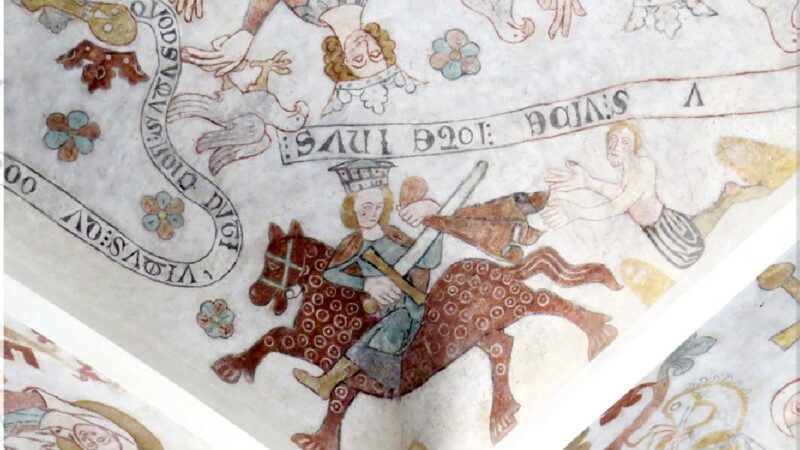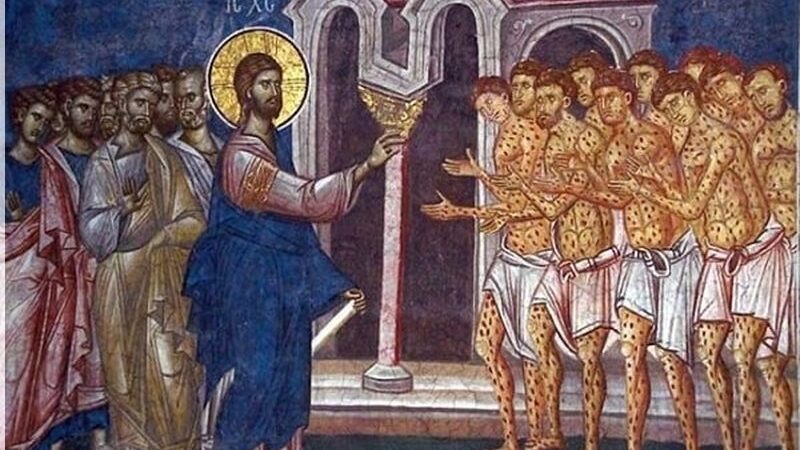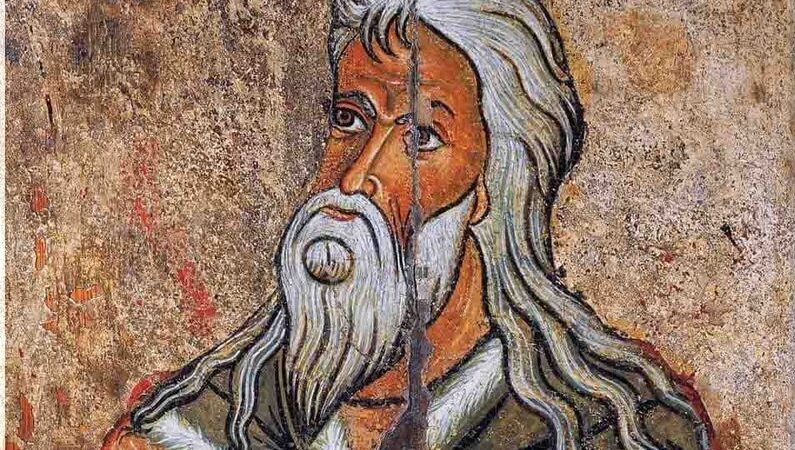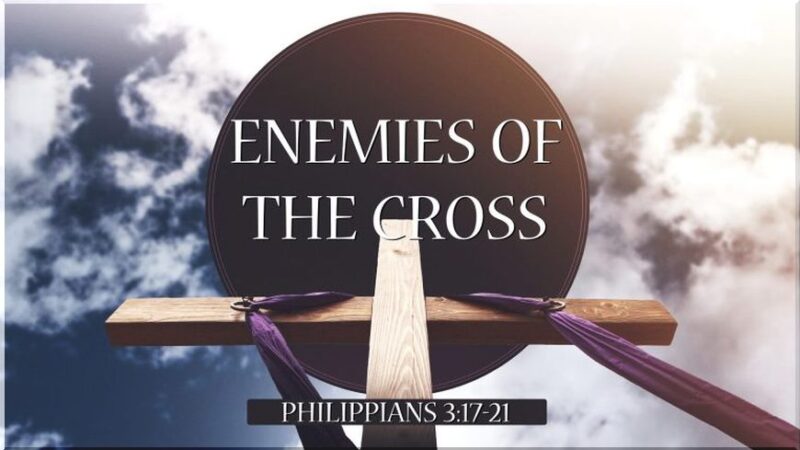The Mind Can’t Explain Foolishness For Christ. St. Xenia Of Petersburg
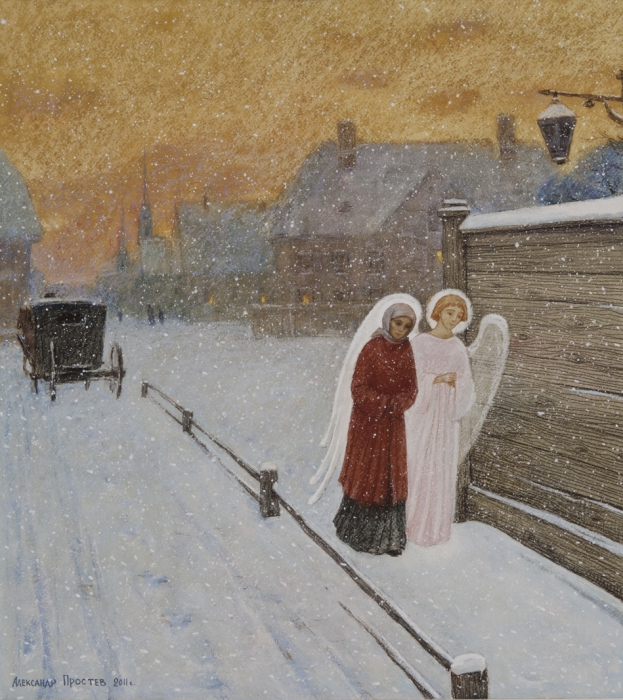
Outside the train window, flickering by are fields, slopes, half-stops, and hamlets with tilting wooden huts and sad-looking cemetery churches with wooden cross blackened by the rain; Russia flickers by the window…
The psychology of a foreign tourist rushing to collect impressions can never understand what it is that those who love Russia love. The soul has to respond. Recall the words of Nikolai Rylenkov:
It’s not enough to see it,
You have to take a closer look,
For bright love
To fill your heart…
It’s all true—to hear, look closer, understand, and… to love—to love forever, to pain of heart!
The closer Russia gets to St. Petersburg, the more it is transformed in both my consciousness and my soul. It always feels like a majestic, sovereign symbol even from a distance, awe-inspiring in its historical grandeur and shining in an aureole of divine trials, but I was filled with special feeling—I was riding with prayer to St. Xenia of Petersburg.
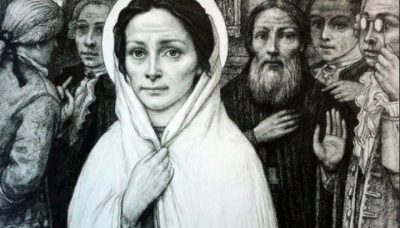
The Smolensk Cemetery
The autumn day was so overcast that even noonday seemed like thickening dusk, but it didn’t take long to find the Smolensk Cemetery—the gates could be seen from afar, its semicircular yellow arches truly marked a window to another world.
The vanity of the big city remaining outside the brick walls immediately lost my attention—here, on this island of eternal rest, you involuntary focus upon the soul’s trembling and feelings, thoughts emerging on life and death, spiritual memory that connects generations, and the vainness of any attempt by this world to find a material measure for the value of human life…
Walking past the crosses and gravestones with crumbling corners and half-erased inscriptions, I am compelled to slacken my steps and contemplate those who have found rest on the shores of the Smolenka River. It is considered that precisely here, somewhere amidst the centuries-old trees, is buried Arina Rodionovna Yakovleva—Alexander Pushkin’s nanny1 (a memorial plaque at the cemetery entrance testifies to this, although the grave is now lost).
The road fortified by red brick leads from the cemetery gates to the sky-blue church dedicated to the Smolensk icon of the Mother of God, also called the Hodigitria icon. The Mother of God will be the Way-Shower to the Kingdom of Heaven for those who strive to live according to God’s laws. They say that Blessed Xenia herself helped to build this church, secretly from others, carrying heavy bricks up the scaffolding by night.
Not far from the Smolensk Church, on the narrow Blok road, are the famous “Beketov” maple trees growing at the base of what was the grave of poet Alexander Blok before his remains were reburied on the Literati Bridges.
Pilgrims who walk to the chapel of St. Xenia of Petersburg bow deeply as they pass by the grave with a white wrought-iron cross—here is buried Anna the fool-for-Christ, who lived in the nineteenth century and possessed the gift of clairvoyance. They say that not long before her death, Blessed Anna came to the Smolensk Cemetery, spread a scarf on the ground, and asked the priest to serve a Pannikhida for slave of God Anna. She was soon to be buried on that spot…
Against the background of a grey sky is seen a black, marble cross with the epitaph, “Grandfather of Russian romance”, N. A. Titov. A little further away is a white slab with an angel in bas relief, the memorial gravestone of the famous archeologist A. V. Tischenko. A marble sarcophagus with angels sculpted at the corners rises grandly over all—this is the gravestone of the wife of Count A. N. Mordvinov…
A thin, aged woman in glasses—one of those they call a “real Peterburger”, carefully adjusting the artificial flower wreath on one of the gravestones, unobtrusively told me an interesting story:
This is the family plot of the Antonovs, and Ivan Ivanovich Antonov, whose grave I’m tidying, was the church warden of the Smolensk Church and adopted son of Prascovia Antonova, who was unable to have her own children. One day, St. Xenia of Petersburg, whose miraculous chapel is located right nearby, came to Prascovia Antonova and said, “You are sitting here darning socks, and you don’t even know that God has sent you a son.” And she told her to drop everything and run to the cemetery. Prascovia was quite bemused, but she went where Xeniushka told her to go. Not far from the cemetery, right before Prascovia’s eyes, a young pregnant woman fell under a carriage horse and after giving birth right on the bridge, passed away. And since the poor girl had no relatives, Prascovia took the boy in and raised him in a Christian spirit.
Then turning her face toward the chapel of St. Xenia of Petersburg, the elderly lady crossed herself and added:
“Everyone loves Xeniushka. She helped everyone and still helps! The main thing is to believe in her help.”
Chapel of Blessed Xenia of Petersburg
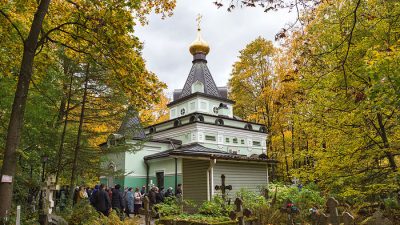
There is a special grace by the chapel. No one here hides their tears. This is it—the final resting place of Holy Blessed Xenia…
It’s full of people, like on the central square of a city, but it’s amazingly quiet—only now and then does the soft singing of pilgrims walking around the chapel break out, as part of an independent “cross procession”.
“We magnify, we magnify thee, our Holy Blessed Mother Xenia, and we honor thy holy memory. For thou doest pray for us to Christ our God.”
The entire chapel is fill with flowers. In the bouquets are notes with prayerful requests. Many of those praying, pressing their foreheads to the chapel walls, weep over their sorrows and ask for help.
It is known that the chapel of St. Xenia of Petersburg was built on parishioners’ donations only in 1902, but before that time there was a small mound on her grave from which people who came there to pray would often take a little earth, and so the mound gradually began to disappear. A new mound on the grave met the same fate. A stone slab was installed. But even this stone slab was little-by-little chipped away by the faithful. Then it was decided to erect a chapel over the grave of Blessed Xenia.
What didn’t this chapel go through: During the war it warehoused bottles from fuels and lubricants; the marble slabs were dismantled from the grave cover, the church utensils stolen, and the icons burned. After the war the city authorities tried to install workshops here—first for shoemaking, then for sculpture… The boarded-up chapel, surrounded on all sides by an impenetrable fence, stood for a long time in desolation—but that did not prevent the multitudes of pilgrims from bringing their woes to Xeniushka and praying for her help.
The entire wooden fence was always stuffed with notes containing prayers and words of gratitude. Only in 1984 was the chapel given over to the community of the Smolensk Church, and in 1988, Blessed Xenia was canonized [by the Moscow Patriarchate] and numbered among the saints of the Russian Orthodox Church.
Blessed Xenia (Xenia Grigorievna Petrova) lived in approximately the second half of the eighteenth century. In shock from her husband’s sudden death without repentance, Blessed Xenia consciously took upon herself the great ascetic labor of “foolishness-for-Christ”, renouncing not only material possessions, but even her own name—dressed in her husband’s clothes, the poor woman announced to her perplexed relatives that “Xeniushka died, but Andrei Feodorovich is alive.” Bringing her own rational mind as a sacrifice to God, Xenia resolved by this to bring down the Savior’s mercy for her beloved spouse.
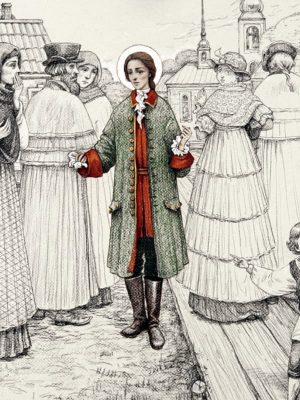
The blessed one’s life was filled with wandering and prayers
She gave all the possession she inherited away to the poor, and began her wandering around Petersburg, enduring cold, heat, and want… With her great meekness and allegorical conversations the blessed one aroused in wicked people, especially in street urchins, the desire to mock the poor woman—they taunted her and threw stones and dirt at her. Blessed Xenia always bore it without complaint.
Little-by-little, people grew accustomed to the blessed one’s eccentricities. For her kindness and meekness people began to offer her warm clothes and money, but St. Xenia always refused to take off her pitiful rags and accept these alms. From good people she would only accept the “tsar on the horse” (kopecks with the image of a horse and rider) but would immediately give these kopecks to other poor people like herself.
During the day, Blessed Xenia wandered around the city, and at night she went out into the field and prayed on bended knee till dawn, making prostrations in all four directions.
People soon began to notice that the “crazy” words of Blessed Xenia were filled with deep meaning, that she had the gift of clairvoyance and healing, and if she would accept something from a merchant at the market, that day would be profitable for him. She especially had the gift of helping the formation of happy marriages.
To St. Xenia for help
The miracles for which the saint had become famous continued even after her death—by the prayers of Holy Blessed Xenia, healings from sicknesses began taking place, and cherished desires of the heart began to come true. Pilgrims from all over the world come to St. Xenia. And today, bending their knees before the white marble grave covering, they come to receive consolation in their sorrows and help in their good intentions, whispering: “Xeniushka, help!”
The ascetic labor of foolishness-for-Christ is unfathomable to the mind. And only the heart is capable of understanding the words of the evangelist Luke: For whosoever exalteth himself shall be abased; and he that humbleth himself shall be exalted1(Lk. 14:11).
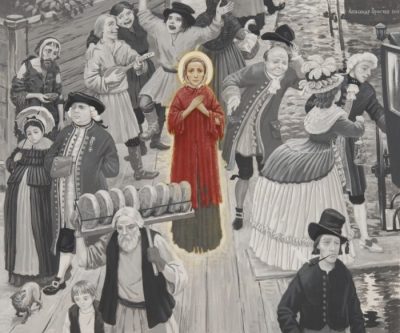
Miraculous Help From St. Xenia Of St. Petersburg In Our Days
“You’ll serve molebens to her in some ten years.”
Marina Zakharchuk
In the late 1970s, when studying at Leningrad State University, I set a goal to visit all churches then opened in the city of Leningrad. Once, I headed for Smolensk Cemetery, named after the church located there. There was something that amazed me during the service, especially during the Pannikhida—the name of Blessed Xenia appearing in each note.
I went for a stroll along the snow-covered cemetery after I left the church, and soon stopped by a locked chapel. There was no one around. I was about to leave, when an elderly woman wearing shabby clothes came from behind the chapel (that I had just walked around).
“What kind of a chapel is it?” I turned to her.
“Holy Blessed Xenia is buried here, my dear. Pray to her.”
“Holy? Why did we pray for her repose? Molebens are usually served to saints, and not Pannikhidas.”
“You will serve molebens to her in ten years,” said the elderly woman. She disappeared as swiftly as she turned up, while I was examining the chapel.
It happened in the winter of 1978. I recollected the encounter ten years later, when the Local Council of the Russian Orthodox Church, opened in the summer of 1988, on the eve of the 1000th Anniversary of the Baptism of Russia, canonized Blessed Xenia of St. Petersburg.
***
“Blessed Xenia asked for two at once.”
Svetlana Galaninskaya
A commentator of the web portal Religare.ru
Blessed Xenia helped both my family and me many times. We always feel her prayers and intercession before the Lord. In fact, she is our family’s patron saint. Thus, commemorating her, we celebrate not only the name day of one of our daughters, but also a kind of Slava [the Serbian Orthodox tradition of glorifying the family’s patron saint].
For a long time after my son was born, I could not get pregnant for various reasons, though I was desperate to. I had always dreamt of a large family. Then I went on pilgrimage that was to radically change my whole life. I travelled to my beloved Xenia of St. Petersburg. Being at Smolensk Cemetery, I prayed that she would plead God to grant me a child. I already had son, and that time I would rather have had a girl, of course. But, believe me, another boy would be a great happiness for me, too. So I promised: If a girl is born, I will definitely call her Xenia.
Blessed Xenia must have pleaded the Lord, indeed… And she asked for two at once, so that I would not grieve so much over the past nine years when I had no children. Unexpectedly, not only Xenia but also Sophia came to our family. While still pregnant, I again travelled to St. Petersburg to thank Blessed Xenia for her prayers, but I had no idea that I was already pregnant with twins.
Amazingly enough, shortly before my pregnancy I wrote to a friend of mine, “I’d like to have a girl, and two girls would be even better.” I did not dare dream about such a happiness—if only one baby were born… Moreover, neither my husband nor I had ever had twins in our families.
In fact, it is frightening when the Lord makes our greatest dreams come true, including those that we did not have courage to ask for. He truly reads it in our heart: “Do you really want to have many children? Then, you will. Now.” My husband would later remind me: “You prayed to Blessed Xenia, didn’t you? That’s the fruit of your prayer.” St. Xenia has intercession before the Lord.
By the way, my twins will turn five soon, in February. They are very kind, generous, beautiful girls, they always help me. Sure, they know perfectly well the story of their coming into this world. Every morning, we pray to the Lord and Blessed Xenia with the words of gratitude.
***
“I began to pray St. Xenia asking her to grant me a husband.”
Irina
In the 1980s, I came upon a small book describing the life and miracles of Blessed Xenia of St. Petersburg. I began to pray to St. Xenia asking her to grant me a husband. Soon I married a very good man. By her prayers, we – my husband and I – managed to miraculously build our private house, though we did not really have any money. Pray to this great God-pleaser, and everything in your life will settle down!
***
“That man had been in prison for ten years on a charge of murder.”
Kira Razdobarina
Hello!
I would like to tell you about St. Xenia’s help. It was not long ago that I chatted with a young man on the Internet. As he said to me, he came from my hometown, but lived in Moscow holding a senior position in one of the factories. Thus, our communication began and lasted for almost a year. We became friends, and I liked him very much. As I presumed from his letters, he was the man I had always dreamt of.
He promised me to meet but was overwhelmed with his work, so there was no chance to meet soon. I was anxious about all that uncertainty. Nevertheless, in my dreams, I perfectly imagined our meeting and future happy family life. A number of people might say I was stupid. Probably, I was. But I was single and quite unlucky in personal life. Therefore, I admit I almost fell in love. I was longing for letters from my new friend.
In the spring of 2013, a friend of mine and I visited St. Petersburg to venerate Blessed Xenia. It was so wonderful there that it beggars any description. Anyone may understand the ineffable joy of coming to her—as if her invisible hand embraced me, instilling a sense of quietude in my soul… I begged St. Xenia to help me arrange a meeting with the man. When I came back home, I began to read the Akathist asking her to resolve the problem.
Soon (about two months after my coming home) I learned that that man was in my hometown; he had been in prison for ten years on a charge of murder. I was not really upset. That was a weight off my shoulders.
A story from Blessed Xenia’s life came to my mind. Once, she did not let a girl marry a man who pretended to be a nobleman, but in fact, was a murderer and had escaped prison. A similar thing happened to me. This marvelous story reminds us that everything in our life happens for a reason. Believe in miracles, pray, be patient and everything will be fine! May the Lord keep you!
***
“The diagnosis was an imminent cause for disability.”
Timothy and Olga Kordonsky
Our story is as miraculous as it is simple. Hardly had our one-year-old daughter begun to walk, when she came down with a fever. A week later, at Moscow’s Filatov Hospital, she was diagnosed with a terrible illness—osteomyelitis of the lift hip. Such diagnosis is an imminent cause for disability. However, a week later osteomyelitis seemed to be a blessing as Nastenska was diagnosed with tuberculosis.
There was only one hospital where children diagnosed with osteomyelitis could be operated on. It was in St. Petersburg. We headed there. The examination confirmed the diagnosis, and we went to Smolensk Cemetery to venerate Blessed Xenia. It was in the evening, and the chapel was already closed by that time. We prayed by its walls, and then wrote a note begging the saint to heal our little child.
Nastya was getting ready for the operation; all the necessary tests had been done, when the doctors announced there was no TB. Moreover, the inflammation in the bone had stopped. She had to undergo an operation anyway. We would never have believed that it all befell us just two years ago but for a scar on the leg, which Nastenka now calls “a little thread”.
***
“They suggested that I terminate my pregnancy.”
Anna D.
My name is Anna, and I would like to share with you my miraculous story about St. Xenia’s help. I have turned to her many times. Her prayers helped me in various occasions: Blessed Xenia helped me to find a work and a husband; I felt her prayerful support when I was pregnant and gave birth to my first child.
When I was pregnant, the baby was diagnosed with Down’s syndrome. We went to Blessed Xenia to pray to her, and a healthy boy was born; he is starting school this year.
We were desperate for another child, but it just wasn’t happening. I was happy when I learned I was expecting a baby. When I came for a regular ultrasound test, the doctor said I had to terminate my pregnancy as the child had a pathology of the internal organs and would not survive. To terminate pregnancy was unacceptable for me, therefore there was only one way out—to pray and give birth to the baby. How could I “terminate” the pregnancy? The baby had both hands and legs, its heart was beating, it was moving inside. I saw another doctor to make an additional observation, but it was all the same.
My husband and I went to the Smolensk Cemetery. Four days later I had another ultrasound test; the doctor could not believe her eyes: there were no problems any more, no threat to life, and everything was almost fine.
I had to have examinations and tests more often than usual, and each time the doctor would get more and more astonished at the miracle. It was the first case in her life. She asked me to give her a call after the child was born. In January, I gave birth to a lovely baby. Now it’s four and a half months old, it’s healthy and cheerful. Finally, I called the doctor, and she said my story proves that we have to believe in miracles and that “there might be some good powers in heaven that help us.” She promised to tell my story to women to stop them from making the irrevocable decision to “terminate pregnancy”.
St. Blessed Xenia, pray to God for us!
“You know where to go!” St. Xenia Of Petersburg comes to Oakland
Nun Cornelia (Rees), 2/6/2014
About fifteen years ago, I heard this story about an event that took place in Northern California – an unusual story, about a miracle of St. Xenia of Petersburg. Nun Nina, now Abbess Nina of St. Nilus Skete in Alaska, had heard it from Fr. Weldon Hardenbrook, who at the time was the rector of a church in Santa Cruz County. I wrote it down immediately, but unfortunately the notebook I wrote it in is located somewhere far away from me now, and I am writing it again from memory – so that people might know that Blessed Xenia the fool-for-Christ of St. Petersburg helps people everywhere, even people who previously knew nothing about her. She helps not only those who have prayed to her, but even those who will pray to her.
This priest, Fr. Weldon, served in a parish that consisted of former Evangelical Christians who had embraced Orthodox Christianity. There was a time when their flourishing community was not Orthodox, and all kinds of people came to them to hear their Christian message. One day, a young man rode up to the church on his Harley Davidson. His appearance betrayed the life of a prodigal, but he was sincerely interested in hearing about Jesus.
A relationship formed with the Fr Weldon, now an Orthodox priest (who told this story), and the young man began to gradually change his ways. He had given up one vice after another when the pastor told him that his “biking” would have to go if he wanted to truly follow Christ. This was too much for the newly-born Evangelical to bear, and he left the community and his pastor’s care, never intending to return.
Our biker rode off on his Harley Davidson, and soon had a terrible accident, which cost him his legs. Eventually he landed back in the company of his old “friends”, in a run-down apartment in a low-rent neighborhood in the bad part of a crime-ridden city. One evening, as he and his companions were abusing drugs and alcohol in a particularly vigorous way, he slipped over the edge and lost consciousness. The others were also far from sober and took him for dead. Not understanding clearly what they should do, and as usual avoiding all contact with the police, they simply dragged his limp, legless body to the street and threw him into the nearest garbage dumpster.
In there, the next morning, he came to his senses. It was a rude awaking indeed to find himself in a dumpster, wallowing in refuse. Climbing dazedly out of that would-be coffin, he sat down on the curb, thinking the darkest thoughts. “So, this is what I have come to. Useless, human trash. Thrown away like garbage.”
Sunk in these pessimistic thoughts, he was suddenly stirred by the presence of an old lady in tattered clothes – what people call a “bag lady”. She was coming closer to him with a fierce, accusatory expression. “You know where to go,” she said, pointing at him. “So, go there!” At that moment the man remembered his former pastor, and the church where he had almost reformed. Determined to find it again, he made his way back to the town where it is located.
When he returned to that church it was different. There were gold domes with crosses on the roof, and the interior was completely changed. No pews; and there was a sort of screen at the front, with strange images of holy people. He looked around in wonder, when his gaze caught the image of a woman – the very “bag lady” who had told him where to go in that hour of dire depression. It was Holy Blessed Xenia, the fool-for-Christ of Petersburg.
He met his old friend, now an Orthodox priest in a cassock, wearing a cross. He received holy Baptism himself, and began to live the life of a dedicated parishioner, this time truly transformed.
I do not know what has come of this man since. I have no reason to believe that he is anywhere other than at that parish, but as I have said, this story was related to me fifteen years ago. However, the fact remains that this miracle of St. Xenia happened to person who knew nothing of her, who lived in a place very far from Russia, and when he needed it the most.
How St. Xenia helped a muslim woman become an iconographer
Olga Lunkova. 2/10/2015
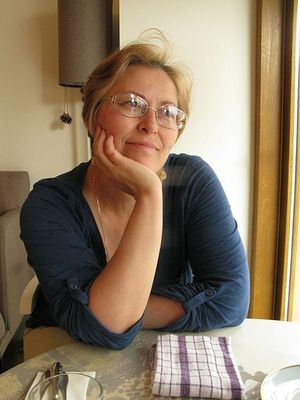
Everything came together in Alla Mescherova’s life seemingly as it should: auditing classes in the Repin Academy of Arts in St. Petersburg, then learning iconography in the “School of Ecclesiastical Arts” in Tver—if it hadn’t been for one thing: Alfia (as her parents named her) grew up in a Muslim family, who held the traditions of their ancestors sacred. Nevertheless, her soul found its home in Orthodox Christianity.
—Few Muslims, especially Muslim women, resolve to change their religion against their family’s wishes. What happened to turn the wheel of your family history around so sharply?
—I was born to a Muslim family. Both of my grandmothers were believers and prayed the namaz. My father’s mother was particularly pious – she prayed several times a day according to the Muslim custom, and she taught me the Muslim prayers. Unfortunately the prayers did not touch me because I was repeating them in Arabic, which I did not understand. Grandmother did not know the translation. As I can remember I searched for a conscious faith, and that is why a trusting relationship with God never came together then.
—When did it begin to come together?
—After completing school I continued with determination to search for the meaning of life, beginning with the entire Koran. But I did not find the answers to my questions in that wise book and so began reading various philosophers: Marxists, idealists, and then Soloviev, Berdyaev, and Rozanov. The last of these nudged me toward Christ.
But my path to Him would be very thorny: At the end of the 1980s, against the background of a general interest in all things paranormal, certain “abilities” opened up in me and for several years I was stuck in the mire of esotericism, then acquiring a mass of various phobias.
In my head then was, in the words of Fr. Andrei Kuryaev, the Russian intelligentsia’s favorite dish – a casserole of Buddhism, esotericism, and theosophy.
It was all flavored with an Islamic sauce and peppered with a vague idea of Christianity. It was then that I began to read the Gospels, and I put them under my pillow at night, because only then could I sleep peacefully; without them I was wracked with nightmares.
In 1987 my grandmother became sick with cancer and by autumn she was bedridden, worrying above all about how she would most likely die in winter and they would bury her in the cold ground.
Then I had a purely coincidental conversation with my teacher while I was sketching on the banks of the Smolenka River, and told him how my grandmother has been near death for over two weeks, and the doctors said she would not live. He offered to take me to Blessed Xenia [of Petersburg], whose chapel was not far away in the Smolensk cemetery, because Xenia helps everyone. When we arrived he showed me where to buy a candle and where to place it.
This was at about four o’clock. I prayed from the heart, asking Xenia to help my grandmother and ease her suffering. For some strange reason I had so much trust in an Orthodox saint whom I did not even know that when I came home that evening I wasn’t even surprised to see my grandmother walking around the apartment, and that she had begun to feel better at precisely four o’clock.
—After this you came to Orthodoxy without any doubts?
—It wasn’t all so simple. By that time I had read the Gospels and went to church regularly, but I did not have the resolve to be baptized. After all, it is a serious step to change your faith. I understood that this would be a blow to my parents, and I feared for their health. I only asked the Lord to give me a clear and comprehensible sign so that I could understand whether it was His will that I be baptized. And one day I came to church on the Smolenka. There were two hours yet before the beginning of services, not many people present, and I stood in the side church of St. Xenia of Petersburg, leaning on the column. Suddenly the space around me changed—everything disappeared.
There was no floor, no ceiling, and nothing at all; however it was not emptiness but a thick dark blueness, almost blackness. It was the black that you see in the mandorla on the Novgorod icon, “Descent into hades.” For a long time I could not understand why the space was dark and only a few years later I read in the writings of Dionysios the Aeropagite that people see Divine uncreated light as darkness.
Well, it was insanely beautiful, absolutely incomprehensible, and my feelings were like what a child must feel at his mother’s bosom—protection and love. Then out of the haze enshrouding the entire area a hand stretched toward me holding a cross on a chain. I reached out with the palm of my hand, and when they placed that cross in it, I immediately returned to reality. The next day I went to be baptized without any doubts.
—Did iconography come as one of the facets of your profession?
—This was God’s will, and it has its prehistory. In about 1994 a global crisis happened in my life: first of all a creative one—I couldn’t paint pictures; second, the object of my love left me, slamming the door loudly; third, I nearly stopped breathing from asthma. But mainly I understood that this whole bouquet of misfortunes was the result of my former, stormy life. But the Lord never abandons us. Seeing that I could not get through this without God’s church, on February 6, the feast day of Blessed Xenia, I literally crawled to her chapel, stood through the services with great difficulty, and afterwards felt significantly better. When finally I stopped feeling like a half-dead invalid, and began to breathe more or less normally, the question came: How should I live from now on? Should I change my profession at age twenty-nine? But painting was not just a profession for me—for eleven years I had worked like one obsessed sixteen hours a day in order to become a painter.
If I were to change professions it would mean that all my labors and sacrifices were in vain and my whole life up to that point was meaningless. Once I had heard about Diveyevo and St. Seraphim of Sarov, and I decided to go to him for the answer to my inner question, although I didn’t have any idea what a monastery was, or a pilgrimage. I went with a friend. We arrived at Nizhny Novgorod without complications but then… Instead of a pleasant three-hour ride in a comfortable bus we stood thirteen hours in a gigantic traffic jam due to a fierce snowstorm. No sooner had this torture on the road ceased than torture from snowdrifts began: For the first (and I hope, last) time in my life I tumbled into snow up to my neck.
I remember the first few days in the monastery like a nightmare. It was very hard. But it was there that I was born again. The woman we stayed with and with whom we formed a friendship within the two weeks we were in Diveyevo asked me one day: “Well, you are an artist. Perhaps you could paint me Blessed Xenia? This request turned out to be absolutely providential. Fr. Vladimir Shishkin came to me personally in the church when he saw my confusion.
I explained my situation and he said that he did not bless me to paint an icon “just like that,” that this is something that must be studied, and therefore he blessed me to go to the iconographic work group of Andrei Zaprudny in Tver. He said it and then ran off on his business. I asked him as he ran away, “Batiushka, what about my parents?! After all, they are Muslims, they won’t understand, and won’t let me go to a strange city…” He just waved his hand as he walked and said, “The Lord will take care of it.” Fr. Vladimir turned out to be right: The Lord took care of it so that my parents calmly accepted the news that I was going to study in Tver. True, I didn’t tell them exactly that this was a school of ecclesiastical arts. Having stepped upon the path of Orthodoxy and a new profession, I always felt God’s help and Providence for me.
—Did you ever think of yourself as an iconographer before this? As an artist you probably always admired the works of Theophan the Greek, or Andrei Rublev?
—Before I was even baptized, in probably 1991, I was at an exhibition from the Russian Museum: Kandinsky, Malevich, Goncharev, Chagall, Philonov… But these painting were not what amazed me – although at the time I also loved all of that – but rather the Russian icons from the collection of Nikodim Kondakov, a famous art historian. This was a feast, an untold feeling of paradise and wonder, and I walked around for a long time as if dumbstruck.
I returned to this exhibition ten times just for these icons, because Chagall, as it turns out, is not interesting even the third or fourth time around. I was astounded by the mastery with which these icons were painted. I saw paradise on them. And this was a discovery for me, because during Soviet times it was customary to look at Russian icons condescendingly. Now Italian Renaissance, that’s something, but an ico – of course it’s nice, but… This admiration of icons lived in me all the years following and became something like a key that would one day open the door into the world of Orthodoxy. This is what probably determined my present festive style.
—When you started painting saints did temptations arise, or did it all go smoothly and blessedly?
—The first icon I painted was the “Flogging of St. George.” The work group was then painting two iconostases for a Belorussian church, and one altar was dedicated to St. George. Then I painted the Trinity for the iconostasis in Diveyevo. In general there were mostly temptations connected with icon painting. I don’t recall any miracles, but temptations – over the top. Especially when you paint an image to go behind the holy table, a cross, or an iconostasis. I painted my first icon for the altar in the early 2000s for the church of St. Sergius of Radonezh in Sertolov, Vsevolozhskovo region of Leningrad province. I had just barely started my work when I managed to crack my rib. I didn’t think to take painkillers, and the doctors didn’t mention it.
The icon board was huge and heavy, and I had to lift it, turn it, take it from the easel, carry it to the table, and then return it again to the easel. Batiushka wanted this icon painted as soon as possible and didn’t consider that I needed sick leave at least for a time after the fracture. Due to constant physical pain I was constantly in a deadened state, and maybe that is why the icon turned out good and prayerful. Everyone said that. The first two icons for my first iconostasis were very hard to do – something was always happening, and then it got a little easier, although it never went smoothly.
One of these icons later streamed myrrh. An icon depicts the higher world. We sometimes forget that Christ’s love is behind this phrase. We depict a world of complete, harmonious Love, which cannot be sad, sorrowful, or gloomy – all of that is human. Orthodoxy is the joy of communion with God. That is why we glorify God, for He brought us the good tidings of Love. This is reflected in icons.
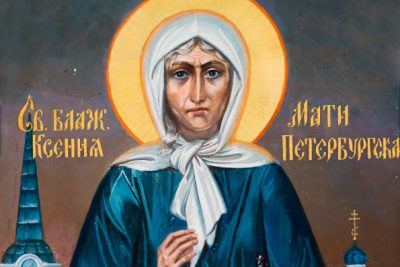
(O. Mayer, O. Rozhneva, A. Pospelov and others. Edited by N.E.W.O.D.)

